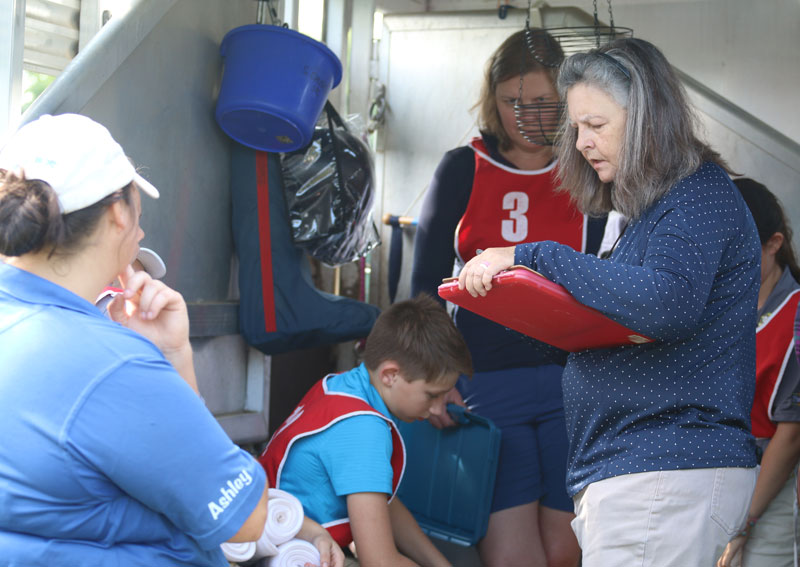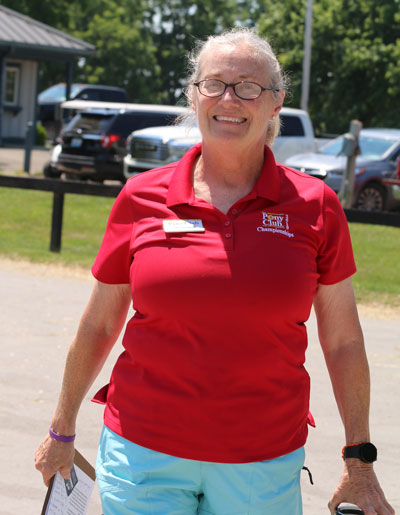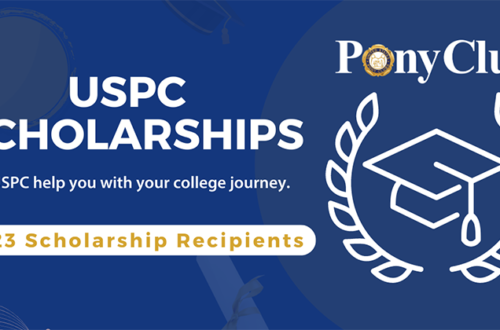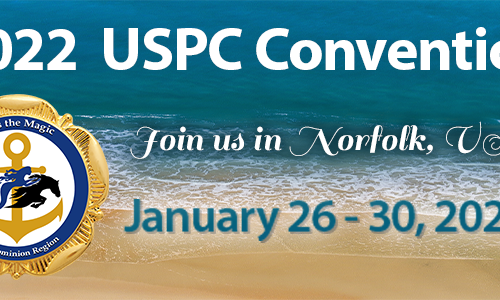
Chief Horse Management Judge: The Unsung Horsemanship Action Hero
By Clare Burkhart, USPC Chief Horse Management Judge
A Chief Horse Management Judge (CHMJ) is a qualified volunteer with the United States Pony Clubs (USPC or Pony Club) who has completed a required, rigorous training process over several years to become an official judge at Pony Club events for the area of Horse Management. To understand all that a CHMJ does in their role, Chief Horse Management Judge Clare Burkhart describes all that they do before a Pony Club rally, during a rally, and after a rally.
The typical CHMJ in Pony Club is usually experienced around horses, loves to interact with others, enjoys teaching and learning, may be a Pony Club alum, and possibly has or had a child or grandchild in Pony Club. Read more about what it’s like to be a CHMJ and all the benenfits from a CHMJ in “Horse Management is Calling: Becoming a Pony Club Judge,” which was published in the Spring 2024 issue of Discover USPC.
Horse Management has always been a basic tenet of Pony Club. It is, quite simply, a required USPC core activity that focuses on members learning the best practices of horse care. Anything to do with the horse EXCLUDING actual riding time is considered Horse Management. Some examples include grooming, first aid, feed and nutritional requirements, safe barn practices, care of tack, bandaging, hoof care, and so much more. Along with riding Standards of Proficiency for all certifications D-1 to A, Horse Management is also an integral element of each standard progression in the certification process. There is a LOT of time dedicated to overall horse care to provide a safe and healthy foundation for the actual riding phases, for sure!
Horse Management (often abbreviated as HM within Pony Club) is a special opportunity for any member, at any age or level, to progress in levels of achievement and knowledge involving the care and management of horses. Horse Management is what sets Pony Club apart from many other equestrian organizations, because members do more than just ride within Pony Club. USPC members are required to be knowledgeable about and hands-on in the care of horses in order to participate and certify at different levels within the organization. Horse Management provides a foundational set of skills within Pony Club.
Useful Materials for a Chief Horse Management Judge
Pony Club members and leaders have access to numerous documents from the USPC website.
- One of the most valuable resources for Horse Management Judges are the Standards for Horse Management, found on www.ponyclub.org under the Education menu item and Standards and Test Sheets, where you find all the Standards for Horse Management by level, along with test sheets and checklists.
- Also under the Education tab, there are D-Level Resources, C-Level Resources, and National-Level Resources (accessible after logging in to the website). You would need to be familiar with these as a Horse Management Judge, but by the time you reach CHMJ level, you should be really familiar with materials from USPC. Topics include bandaging, breeds and conformation, feet and shoeing, health care and vet knowledge, leading and longeing, nutrition, recordkeeping, stable management, travel safety, turnout and tack, and more.
- If you dive into those menus on the Resources pages, you’ll find quizzes by level.
- If you continue down the Resources pages for the level you want, you’ll find study guides for the various levels of D-1 to D-3 and C-1 to C-2 (C-3 is a national level).
- You can also find links to the manuals and flash cards, which are crucial for anyone needing Horse Management information from Pony Club.
- You can access Pony Club IQ, which has an abundance of articles organized by level and topics.
- In addition, once you are logged in, under the Teach menu item is a link for “Education and Instruction Ideas,” which has an “HM Curriculum Outline” link, a “Teaching HM in 12 Months,” and a link to the Horse Management Guidebook. This guidebook provides valuable advice stated in a clear, understandable manner for any interested member, instructor, or Pony Club leader.
- Lesson Plans, which includes Horse Management Lesson Plans in its own section, and Teaching Tools are also under the Teach menu, but the teaching tools are mostly for riding.
There numerous resources for HM on the website help the CHMJ to do their job of sharing Horse Management knowledge with Pony Club members.
The CHMJ must regularly complete updated HM training seminars and is keenly aware of the various expectations of each Pony Club certification level concerning the care of the horse, equipment, and stable safety. Many of the HM documents are generated by the Horse Management Committee. There are many Chiefs across the country contributing to various aspects of HM instruction for the HM Committee or for other Pony Club committees. Many CHMJ folks will conduct HM clinics for members when asked by clubs, centers, or even regions who need someone to help teach the concepts, and most are happy to do so to help members prepare for certifications and rallies.
Since a standard qualifying rally cannot happen unless there is a nationally approved Chief Horse Management Judge, let’s take a look at the complete process involved for the CHMJ.
Prior to Rally
- The Regional Horse Management Organizer (HMO) will contact and hire a CHMJ from the approved list on the USPC website for a particular rally. HMOs are encouraged to hire a CHMJ from outside the region to encourage optimal learning opportunities for all involved.
- Once hired, the CHMJ contacts the rally organizer to touch base on particular facts about the rally itself, the venue, and for any other details important to the competition.
- The CHMJ communicates with the Assistant Horse Management Judge (AHMJ) staff to make an introduction and outline basic guidelines before arriving at the rally, if possible.
- The CHMJ will communicate about payment, which varies based on what the CHMJ prefers for a day rate and reimbursement of travel expenses, and will discuss who will make the travel arrangements with the Horse Management Organizer (HMO) and the Rally Organizer. Each rally may do these things differently.
At a Rally

- Once on the grounds, the CHMJ performs a barn walk-through to be familiar with the facilities, special instructions for use of the venue, and any other information that the Rally Organizer specifies for the duration of the rally.
- The CHMJ will hold a briefing for the Assistant Horse Management Judge (AHMJ) staff, setting the tone of the rally, as well as the expectations for staff interaction with members.
- The CHMJ organizes any provided paperwork.
- The rally begins after the organizer and the Chief hold the official briefing for competitors, parents, leaders, and coaches. This is often when the Chief introduces the AHMJ staff and answers any questions.
- Once competition begins, the AHMJ staff will proceed to do the first set-up and safety checks for all competitors. Whether using stabling or doing a trailer rally, the initial inspection should include inspection of water and feed buckets, halter fit, stall cards, and tack and feed room set-up.
- Assistants will also check the Required Equipment List for each team, checking for necessary items in each kit, such as grooming, equine first aid, human first aid, tack cleaning, utility, and extra equipment.
- Assistants will organize competitors for the Horse Inspection (jogs) which the CHMJ, Technical Delegate (TD), a veterinarian, and possibly the farrier will observe to determine if the mounts are serviceably sound for competition.
- Daily Sheets will be kept for the teams, noting such things as quality Horse Management and organization, positive teamwork, areas for improvement, and possible deductions for infractions, such as unsafe handling of a horse or unauthorized assistance (e.g., such as a parent helping a member).
- Turnout Inspections are the area where members love to shine! Assistants perform the inspections, and mark “Exceeds Standards” for each item on the sheet, which are eagerly sought after and rewarded accordingly!
- The Chief is the only one who scores each specific part of HM, and scores are posted regularly for competitors to review or to make Inquiries.
- Inquiries are merely questions about a score in Horse Management. These questions become “teaching moments” for the CHMJ as competitors learn to respectfully express themselves using their knowledge of their discipline’s rulebook to advocate their cause. If they are not satisfied with the CHMJ response, they may proceed to appeal to the next level of officials.
At Rally End
- The CHMJ provides a debriefing for the AHMJ staff and for the competitors as time allows.
- The HM staff distribute HM evaluations to competitors, which are collected and given to the HMO. These evaluations are used to determine what areas of Horse Management competitors would like more practice, and also what changes and suggestions need to be addressed for the entire HM staff as a whole.
- The CHMJ completes evaluation forms for the AHMJ staff as well as the Provisional Horse Management Judge if there is one, to be turned over to the HMO. If there has been a PHMJ, they have been under the supervision of the CHMJ.
- All paperwork for each team is compiled by the CHMJ to give to club leaders at the awards ceremony.
- The organizer and the CHMJ may confer on procedures for future rallies, including completing incident reports, if necessary.
- The CHMJ will complete the Annual Chief Report to the National Office for each rally by December 1.
Becoming a Chief Horse Management Judge

To become a Chief Horse Management Judge in the USPC is an honor that requires dedication and commitment to seeking out excellence in Horse Management. Some applicant requirements include the following: being a minimum of 24 years old; has been an active AHMJ for a minimum of two rallies a year for at least two years, but no longer than three years; completing the Membership Protection Training (SafeSport), first aid certification, heat illness training, favorable background check, head injury modules (concussion) through the National Office, and being a Life or Corporate member of USPC. For the complete process and to learn more about what it’s like, read “Horse Management is Calling: Becoming a Pony Club Judge.”
While this may appear to be a daunting list of requirements, any volunteer in most youth organizations is required to complete most, if not all, of the above requirements in order to coach, teach, or mentor people under the age of 18, as well as adults. The opportunity to share knowledge with like-minded equine enthusiasts is only one of the positive outcomes of volunteering in Horse Management. We hope you become a Horsemanship Action Hero!!!!
How Can I Get Started?
- Volunteer to scribe at Turnout inspections at rally: there is a plethora of knowledge to be gained by observing!
- Participate in your region’s HM seminars, which are typically held annually or biannually.
- Shadow a CHMJ or experienced AHMJ during a rally.
- Observe/learn how to do a Safety Check at your local Pony Club meeting.
- Ask questions: you will never know unless you ask!
- Attend the USPC Annual Convention. There are many, many opportunities to learn from the best of the best in Pony Club, and USPC Chief Horse Management Judges usually have a session at the convention.





